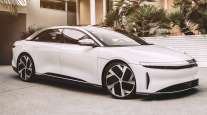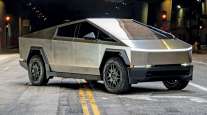Collaboration Needed for Electric Vehicle Market to Thrive, Experts Say

OAKLAND, Calif. — A strong collaboration among all parties involved in the life cycle of electric vehicles, including original equipment manufacturers, fleets and utilities, is needed to advance the technologies.
That was the consensus of panelists taking part in the GreenBiz Verge Conference here Oct. 16-18.
RELATED: UPS, Walmart find electric vehicles offer benefits, opportunities
“It takes a careful and close collaboration with all of those representatives to move this EV pathway forward,” said Tamara Barker, chief sustainability officer for UPS Inc. and a speaker on the panel “Why Early Adopters Are Electrifying Fleets.”
Barker addressed the topic with Mike Roeth, executive director of the North American Council for Freight Efficiency; Dakota Semler, CEO of Thor Trucks; and Nate Springer, manager for climate and logistics at Business for Social Responsibility.

Thor has created an all-electric Class 8 truck. (Thor Trucks)
“Infrastructure deployment for fleet electrification is only going to happen with collaboration. Utilities can work with fleets, fleets can work with utilities and everyone works together,” Semler said.
Roeth noted that as battery costs have come down, performance has improved and their weight has declined. “This isn’t a fad, and we’re finding that with our work that it is real and it is happening,” Roeth said. “There are benefits to the early adopters now.”
However, challenges remain, and Roeth said it is essential for electric trucks to be placed in the right duty cycle to be successful. “We have to make sure collectively that we choose the deployment projects well so customers can be successful and we can learn more and more,” he said.
Semler agreed that if there is an unsuccessful roll out, it sets the entire industry back.
Roeth and Semler said applications with high frequencies of starting and stopping and that are close to home make the most sense. More than 60% of the vehicles in commercial operation are in shorthaul, return-to-base applications, which also fit the use-case scenario for a successful electric vehicle roll out, Semler said. He added that today there is an economic case for electric vehicles, which wasn’t the case five to 10 years ago.

In our fifth episode of RoadSigns, we ask: How far can we go in terms of automating freight transactions? Hear a snippet above from Ziad Ismail, chief product officer at digital freight matching firm Convoy, and get the full program by going to RoadSigns.TTNews.com.
In a new study by UPS and GreenBiz titled, “Curve Ahead: The Future of Fleet Electrification,” 55% of respondents said the initial purchase price of commercial electric vehicles is the top barrier facing the technology. Another 44% viewed inadequate onsite charging infrastructure as a barrier, and 92% said their facility is not well-equipped to accommodate commercial charging needs.
Barker discussed the survey during the panel. She added that conversations surrounding electric vehicles need to take place on a site-by-site basis and depend largely on what the electric grid at each location can support. That helps all parties determine if vehicles can be accommodated, if a utility can add to the network or if the grid is already 100% utilized.
Roeth noted that creating the charging infrastructure may be more difficult depending on scale. “If you’re doing one truck, you can put up a stand. If you’re doing a bunch of trucks, you’ll have more work to do, and you have to tear up concrete in some cases,” he said.
UPS has learned valuable lessons from its early involvement in electric vehicles, Barker said. She suggested that all parties that will be impacted by electric vehicle decisions be involved in the early decision-making process. “Where you decide to put the chargers may work for eight hours of the day, but the other eight hours there may be another operation,” she said.
Fleet managers and industry experts taking part in the UPS survey said starting small can help companies overcome the challenges. Instead of undertaking a large-scale fleet overhaul, many companies will prioritize electric options when replacing vehicles and even consider electric leasing options to mitigate the initial purchase price, the study said.
The study showed that the top motivation to go electric for 83% of large businesses surveyed is sustainability and environmental goals. A lower total cost of ownership, factoring in both direct and indirect costs and savings over the life of the vehicle, is the second biggest driver, cited by 64% of respondents. Besides fuel savings, electric vehicles typically require less maintenance than traditional internal combustion engine vehicles, which means lower maintenance costs, UPS said.




